Mad Hedge Biotech and Healthcare Letter
November 15, 2022
Fiat Lux
Featured Trade:
(A FAIL-SAFE PASSIVE INCOME BIOTECH)
(AMGN), (AZN)
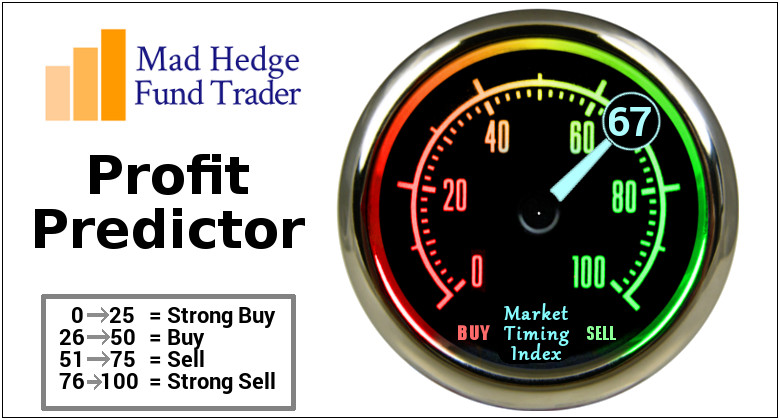
Mad Hedge Biotech and Healthcare Letter
November 15, 2022
Fiat Lux
Featured Trade:
(A FAIL-SAFE PASSIVE INCOME BIOTECH)
(AMGN), (AZN)

Loading up on high-quality stocks, particularly those that deliver passive income, is an excellent strategy to ride out this bearish market. This all but guarantees a dependable cash flow and offers a way for investors to limit losses.
Obviously, blue chip stocks tend to be among the first businesses to rally after marketwide crashes.
Among the top-tier passive income stocks in the biotechnology and healthcare industry, one of the names that stand out is Amgen (AMGN).
This blue chip biopharmaceutical business prides itself on consistent free cash flow and a solid track record of boosting its dividends on a regular basis.
So far this year, Amgen’s shares have climbed by an impressive 30.6%. This led to the biotech’s stock rising and surpassing its 52-week highs. For a bit of background, the S&P 500 has declined by 20.3% to date, while the Nasdaq Composite has fallen by a disappointing 32.9%.
Clearly, Amgen’s shares are beating the broader market this year.
Moreover, the company is currently trading at $291 per share, breaking through a resistance level set at a high 250s earlier in 2022.
A key reason for Amgen’s ability to defy this challenging bear market is its strategy to focus on the business of developing and selling critical, life-saving treatments.
One of the most exciting drugs in its portfolio is AMG-133, which is a new obesity drug. This is estimated to enter Phase 2 trials by 2023, with shareholders anticipating approval soon since the drug’s latest data showed “impressive efficacy.”
In terms of sales opportunity, AMG-133 can target a lucrative sector. The total market for this drug is estimated to be worth over $10 billion every year. This would translate to a multibillion-dollar revenue stream for Amgen.
Another promising drug in Amgen’s portfolio is asthma medication Tezspire, which it developed with AstraZeneca (AZN). This treatment holds considerable potential, showing off a 300% growth from its first-quarter sales to record $29 million in revenue in the second quarter.
So, even if some products, such as the white blood cell treatment Neulasta, tend to weigh on the company’s top line, Amgen still manages to generate massive free cash flow every quarter and annually.
To illustrate this point, Amgen’s free cash flow in the third quarter of 2022 reached a whopping $2.8 billion. Meanwhile, the company’s sales hit $6.65 billion, beating analysts' expectations, while its earnings per share were at $4.70
What does this imply?
It means Amgen is an ultra-safe passive income investment. The biotech’s substantial free cash flow can easily cover its annual dividend yield of 2.88%.
Since it first started distributing quarterly dividends back in 2011, Amgen has boosted it annually.
The company’s management has been consistent in its commitment to boost the dividend yield, rewarding shareholders with a jaw-dropping 1,257% increase over the last 10 years.
In 2022, Amgen announced a 10% increase in its dividend to reach $1.94 per share. At its current figure, Amgen’s yield is 3.08%. That’s almost double the S&P 500 average dividend yield of 1.82%.
More importantly, Amgen has a slew of new drugs that look incredibly promising. As of the last update, there are 40 candidates queued for Phase 2 and 3 trials.
This is crucial because several existing drugs in its portfolio are anticipated to experience a decline in sales over the following years due to patent exclusivity losses and the entry of more competitors.
All in all, Amgen is proving itself to be quite the recession-proof biotech thanks to its stellar free cash flow and heavily dependable dividend program. Needless to say, it is an excellent stock to own, particularly in a brutal bear market.
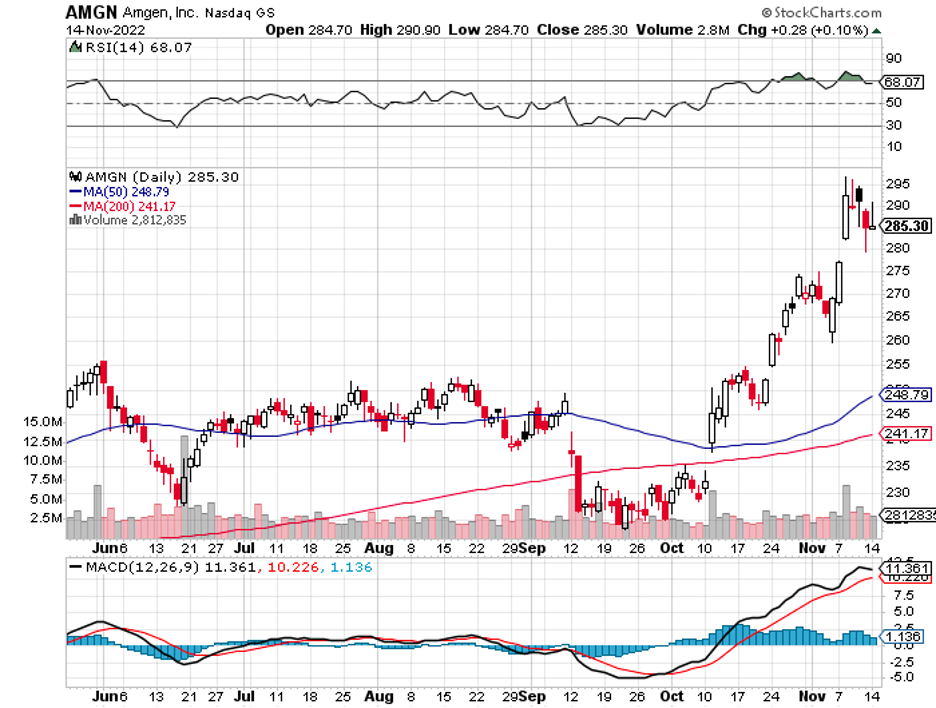
Mad Hedge Biotech and Healthcare Letter
September 6, 2022
Fiat Lux
Featured Trade:
(ONLY FOOLS RUSH IN)
(APDN), (RVPH), (NERV), (JNJ), (BMY), (AZN), (LLY), (PFE)
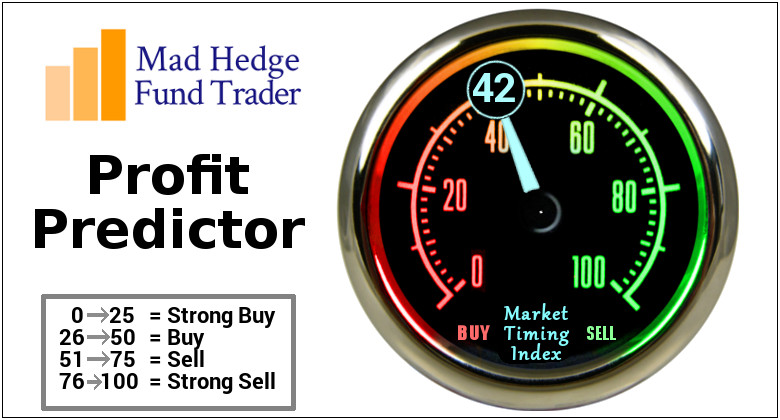
Following a promising first half of 2022, it looks like the markets are taking an about turn as more and more investors start dumping their stocks.
The seemingly recovering Nasdaq Composite showed a 4.3% decline last month despite reporting its best record since 2020 just last July.
Nevertheless, several biotech names appear to have avoided the crash thanks to some exciting company-specific updates.
The top gainers so far include Apple DNA Sciences (APDN), which skyrocketed 340% by the end of August. Among the projects in its pipeline, the most promising to date is its monkeypox virus test.
Another name on the list is Reviva Pharmaceuticals Holdings (RVPH). This clinical-stage biopharmaceutical firm reported a whopping 244% gain during its second-quarter earnings report.
However, the top gainer that has been on the news lately is Minerva Neurosciences (NERV). This budding biopharmaceutical company gained 321%, according to its report last month.
Minerva Neurosciences isn’t a name I have kept track of nor even heard of until these past months when its wild upswing started to make me curious.
The company started attracting attention when billionaire Steve Cohen of Point72 Asset Management fame invested in it. This move saw Minerva Neurosciences’ shares soar to more than 70% at that time.
Just before August wrapped up, the company filed for its long-delayed schizophrenia treatment, Roluperidone.
Entering the neuroscience industry is a clever move, especially with the potential of this segment. In 2021, this market was estimated to be worth $32.22 billion. By 2027, the neuroscience segment is projected to reach $41.24 billion.
As for schizophrenia, roughly 1% of the entire population is affected by this disease. Based on recent WHO reports, more than 24 million individuals are suffering from schizophrenia annually.
In 2021, the global schizophrenia drug market was reported to cost $8.02 billion. Taking into consideration the changes in the environment and living conditions, the number is expected to go higher as the years pass. With these in mind, the estimated worth of this market is expected to reach $10.15 billion by 2027.
Minerva Neurosciences wouldn’t be the first to take interest in the schizophrenia segment. Prior to this biopharma’s entry, there have already been a handful of key players attempting to be hailed as the leader of this sector.
The names include Johnson & Johnson (JNJ), Bristol-Myers Squibb (BMY), AstraZeneca (AZN), Eli Lilly (LLY), and Pfizer (PFE).
However, only Minerva Neurosciences specifically targets the negative symptoms of schizophrenia. That makes the company stand out in this steadily growing segment.
Given that Minerva Neurosciences is cheaper than these stocks, would it then be wise to buy shares from the smaller company to gain entry into the neuroscience market?
At this point, Minerva Neurosciences has yet to prove that it’s more than just a one-trick pony. In fact, the company has not even sufficiently shown that it has mastered its single trick.
When looking at the potential of any biotechnology and healthcare company, I generally begin by checking out its pipeline.
For Minerva Neurosciences, the list does not look sustainable.
The company’s MIN-301 for Parkinson’s Disease remains inconsequential since it’s still in the preclinical trial stage.
Prior to this, Minerva Neurosciences worked with JNJ to develop treatments for insomnia and major depressive disorder. However, those have yet to yield tangible results that can move the needle for the company’s share price.
That means Minerva Neurosciences is all about Roluperidone. While the company is moving as fast as it could to launch the product to market, more questions remain than answers.
Actually, the company seems to have eliminated earnings conference calls. These could have been useful in offering a more accurate picture of its future, but it looks like investors will need to make do with whatever information is published.
Admittedly, exciting times could very well be waiting for Minerva Neurosciences’ shareholders. The recent progress with Roluperidone most likely offered them some relief.
No doubt that the optimistic investors are hoping that the 321% gain would signify another incredible run in the following weeks. However, this might not be likely. In fact, a pullback seems to be more in the horizon.
Considering its sparse pipeline and the lingering uncertainty over Roluperidone’s performance, this might not be the best time to buy Minerva Neurosciences’ shares.
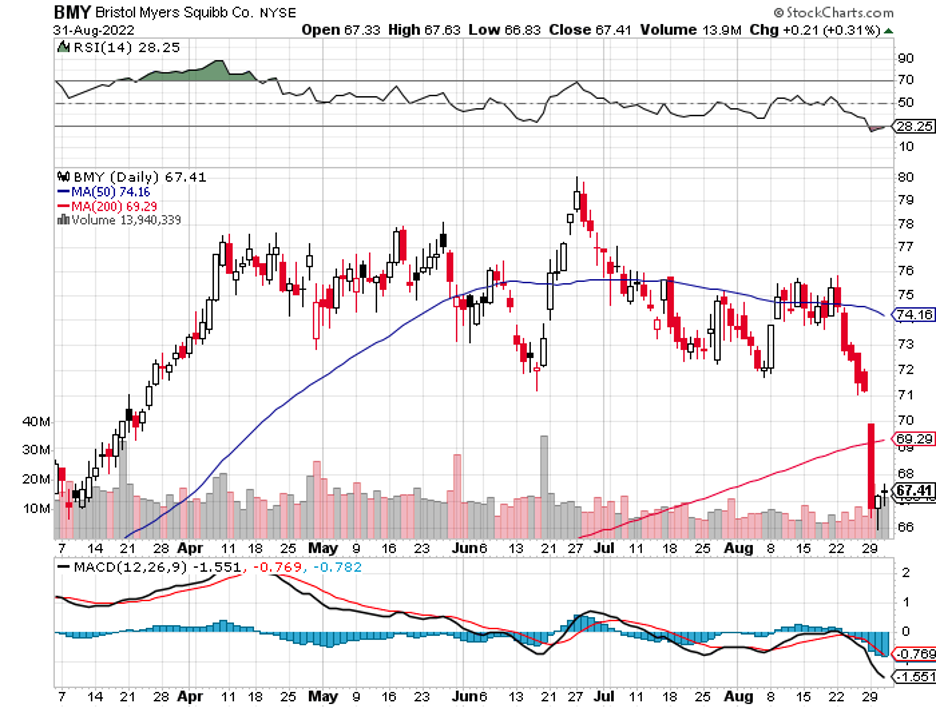
Mad Hedge Biotech and Healthcare Letter
July 14, 2022
Fiat Lux
Featured Trade:
(GOODBYE BIG PHARMA, HELLO BIG BIOTECH)
(GSK), (PFE), (BMY), (VTRS), (LLY), (JNJ), (AMGN), (GILD),
(MRK), (RHHBY), (AZN), (NVO), (ABBV), (SNY), (ABT)
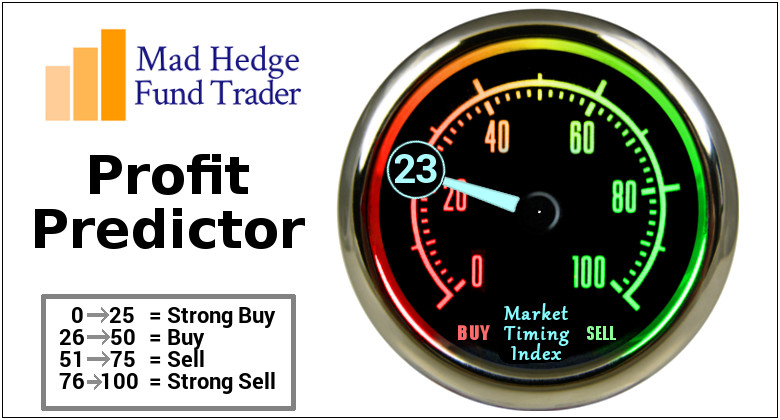
The moment GlaxoSmithKline (GSK) completes the spinoff of its massive segments marketing drugstore staples, such as Tums and Advil, it will become the latest name to join the list of Big Pharmas shuffling their assets and rebranding itself into a pure-play biopharma stock.
The reorganization of this UK-based company is the culmination of years-long process that has transformed practically all the biggest pharmaceutical companies globally into biotechnology companies on steroids.
This type of transformation, which gets rid of sideline businesses, has been going on for years. Pfizer (PFE) dumped its chewing-gum segment back in 2002 and established another spinoff unit, Viatris (VTRS), with Mylan in 2020.
Bristol Myers Squibb (BMY) decided to spinoff its infant-formula division in 2009. In 2018, a new animal health company came to be from Eli Lilly (LLY).
By 2023, Johnson & Johnson (JNJ) expects to complete the creation of a spinoff company and unload its consumer health segment, which offers Tylenol and Band-Aids.
Essentially, they’re turning into Amgen (AMGN) and Gilead Sciences (GILD) but with more money and resources to churn out high-priced, complex treatments for rare diseases.
However, not all Big Pharma names plan to become pure-plays. For example, Merck (MRK) still intends to retain its animal health sector while Roche (RHHBY) wants to keep its diagnostics segment.
As for the rest, including AstraZeneca (AZN), Novo Nordisk (NVO), and AbbVie (ABBV), their plan is to focus on creating new drugs and marketing these treatments—nothing more, nothing less.
The idea of Big Pharma transforming into “Big Biotech” dates back to 1992, when Henri Termeer, the CEO of Genzyme—now owned by Sanofi (SNY)—was summoned to a Senate hearing in Washington to argue and justify one of the most expensive medicines ever put to market.
The medication in question was for a rare genetic condition called Gaucher disease. A year-long treatment for one person needed tens of thousands of human placentas, and the price tag? A jaw-dropping $380,000 annually.
Amid the demand to make the treatment cheaper, Genzyme stood by its decision and the price barely budged after two years.
The company’s tenacity and insistence on standing by its pricing altered the biopharma landscape. That is, drug developers realized that rather than marketing cheaper drugs to combat common diseases, they can focus on biotech-style treatments to target rare conditions.
At that time, Big Pharma companies were battling over pieces of massive markets. They allocated considerable funds to their commercial teams, hoping to outrank one another in crowded spaces.
Meanwhile, biotechs like Genzyme decided on a different strategy.
They concentrated on more innovative approaches. Actually, the biotech focused on biologics at that point. Then, the company simply ignored the pricing rules and set its own prices, which were considerably higher.
A more recent go-to proof of concept for this strategy is Abbott Laboratories (ABT), which was initially a diversified company that offered an extensive range of products like medical devices and even infant formula.
In 2013, the company spun off its branded pharmaceutical sector into AbbVie, which became a pure-play biopharma that focused on developing and marketing the arthritis drug Humira. Since then, Humira has transformed into one of the top-selling drugs in history.
More than that, AbbVie pays substantial dividends while its shares have delivered 500% returns since the spinoff. In comparison, the S&P 500 has returned roughly 220% within the same timeframe.
While this is a shift that investors have clamored to see in the healthcare sector, it also means that the transformations could turn companies with solid revenue streams that have become reliable despite the ups and downs of the drug discovery process into riskier bets.
Although treatments for rare diseases admittedly come with very high price tags, focusing on smaller markets brings with it the inherent risk that these buy-and-stuff-under-the-mattress blue chips could no longer deliver returns as consistently.
These days, though, the advancements have made faster and safer scientific breakthroughs much more plausible.
Companies have gained a better understanding of the human genome, oncology treatments, genetic diseases, and groundbreaking modalities like gene therapies.
The science has now caught up with the demand. More importantly, Big Pharma has finally woken up and started to leverage its resources to take advantage of the opportunities.
This gradual change can be seen in the surge of new treatments in the past years. From 2016 to 2020, the FDA approved an average of 46 new therapies annually.
This is more than half the number between 2006 and 2010 when the organization only approved an average of 22 new treatments every year.
Needless to say, these changes are also partly in response to the overall dissatisfaction of investors with the diversification strategies of Big Pharma.
Basically, the general message here is that Big Pharma should let the investors worry about diversifying their own portfolios and focus on developing safe and effective drugs.
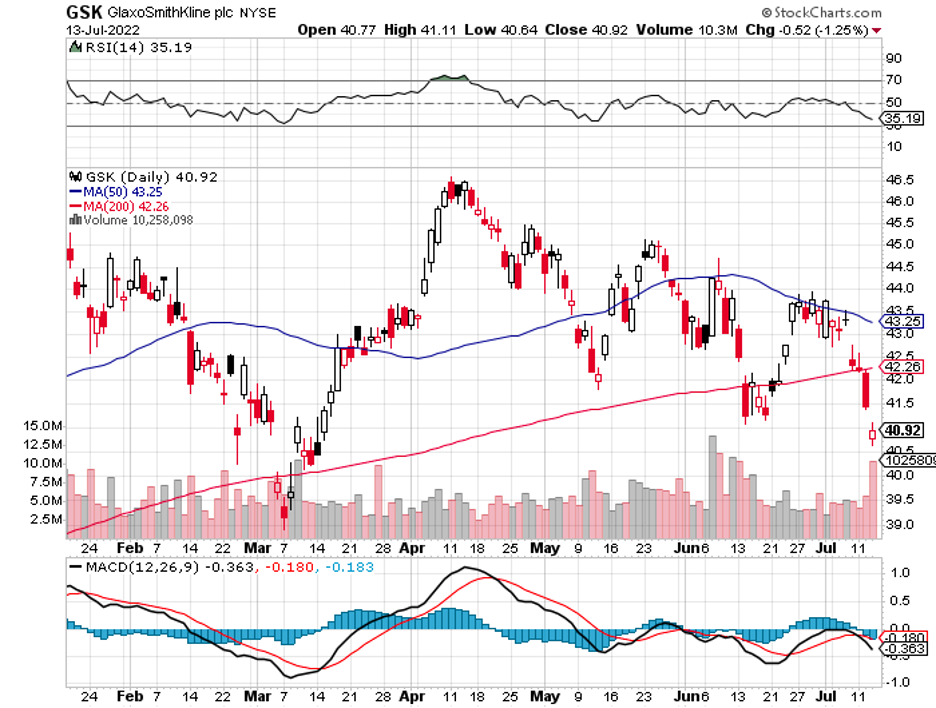
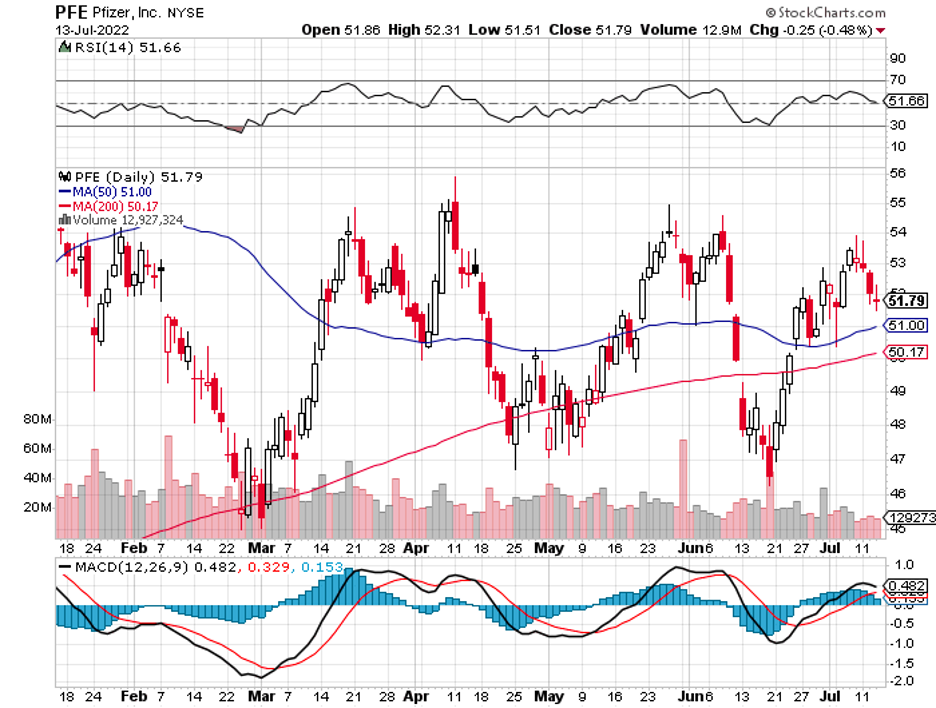
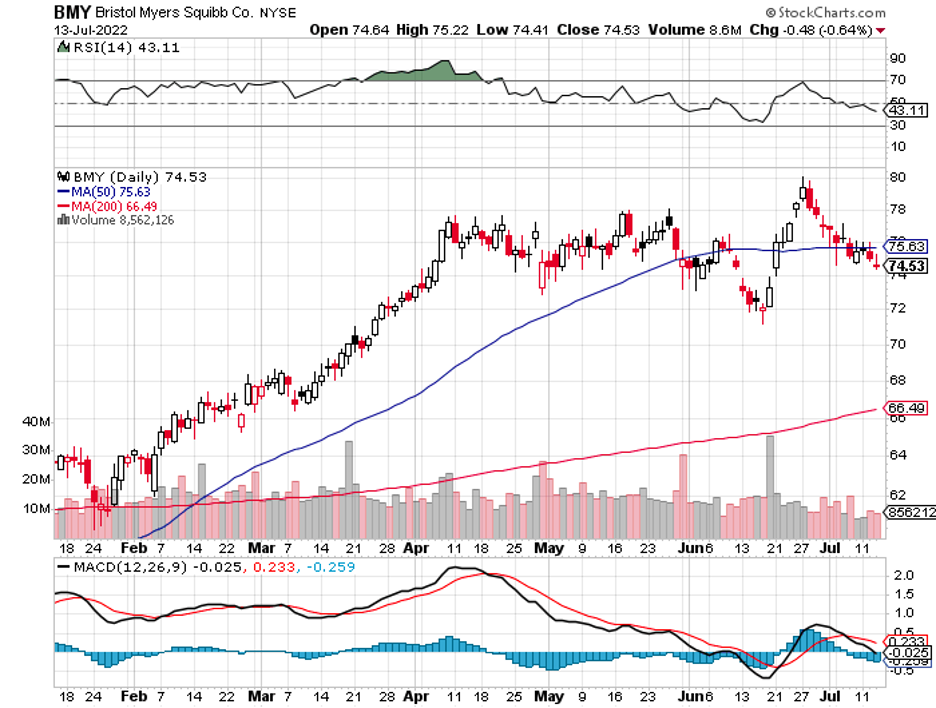
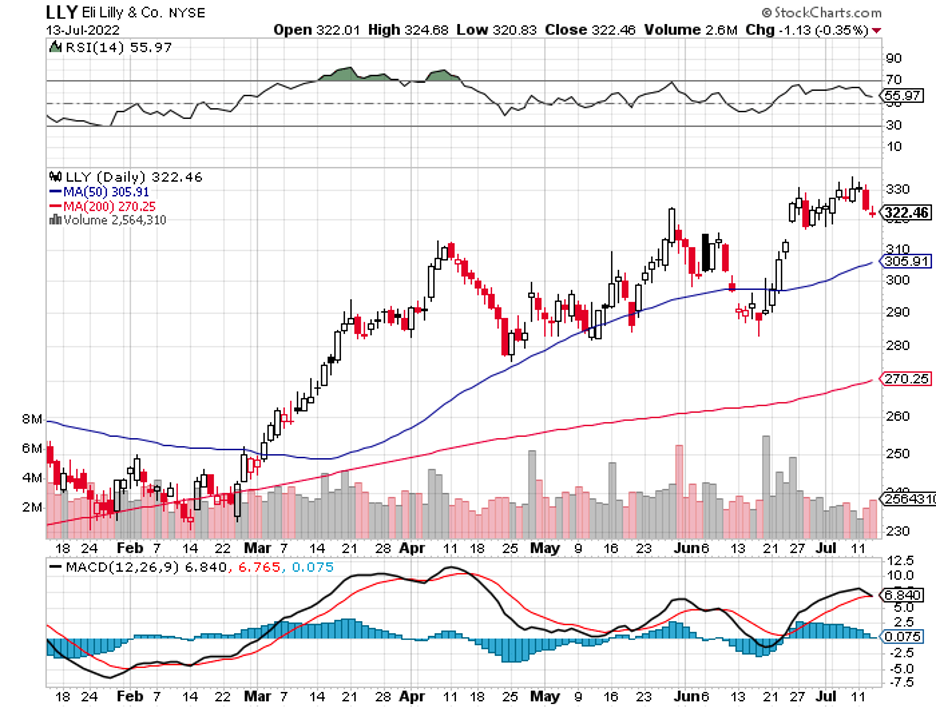
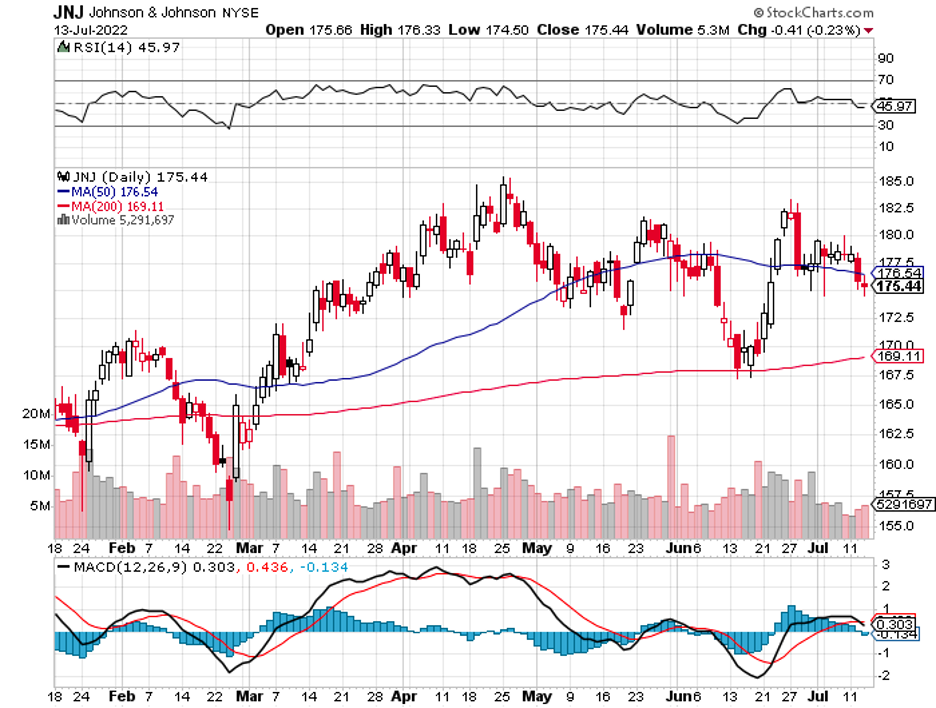
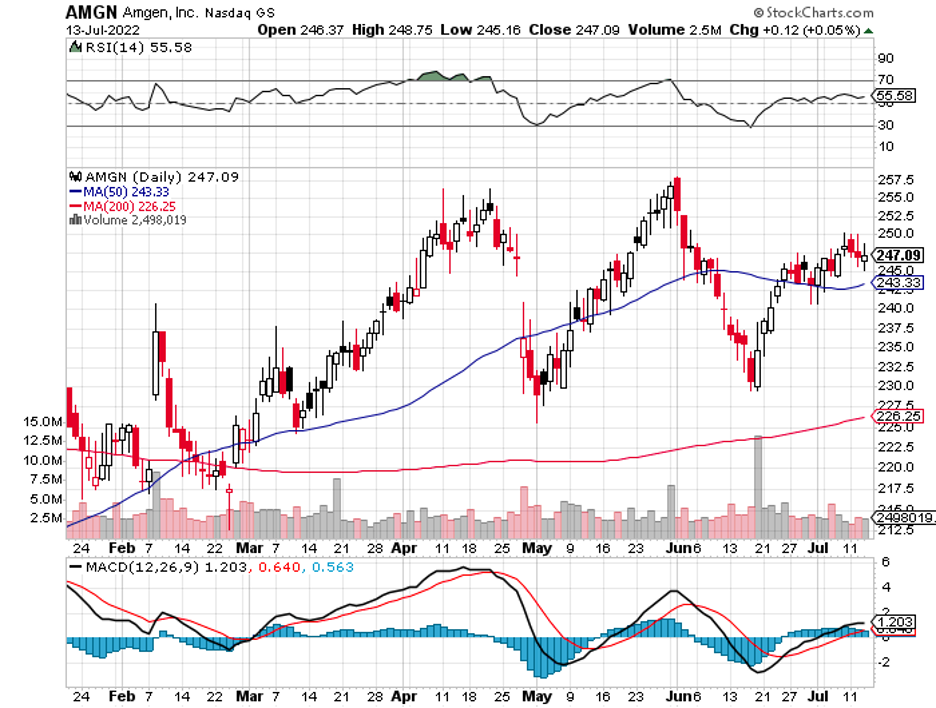
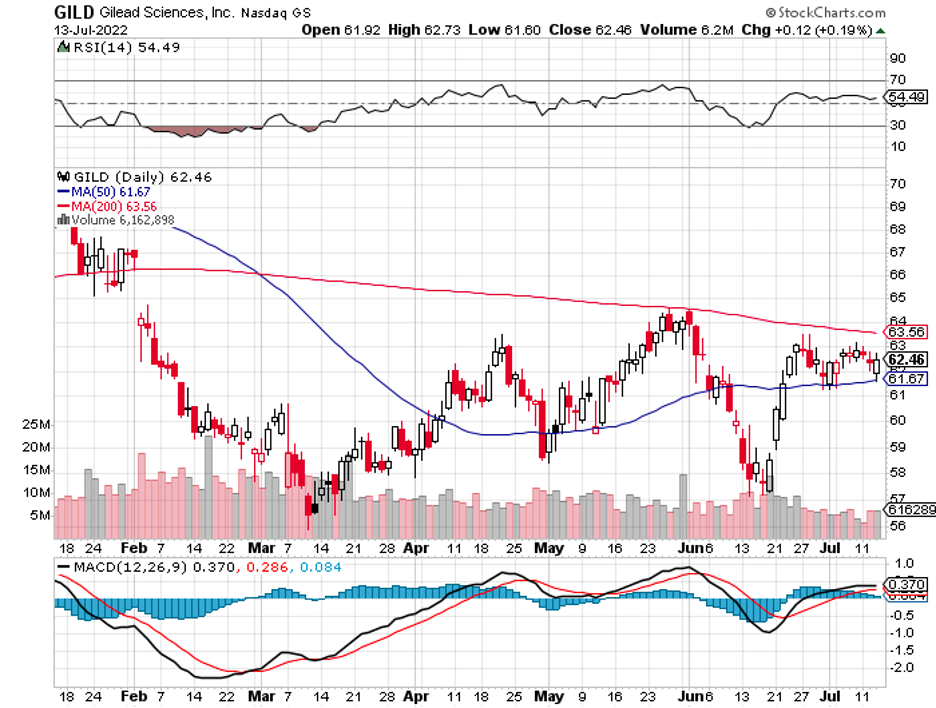
Mad Hedge Biotech and Healthcare Letter
June 30, 2022
Fiat Lux
Featured Trade:
(A SOLID BIOPHARMA WITH A GAMECHANGER UP ITS SLEEVE)
(MRK), (SGEN), (AZN), (ABBV), (BMY)

The mounting uncertainty over fears of a global recession, heightened volatility, and ongoing geopolitical concerns resulted in the decline of the S&P 500 index, pushing it towards a bear market.
In this type of environment, investors can lean on solid dividend stocks to smooth out losses and generate some much-needed passive income.
A great biotechnology and healthcare stock that fits the bill is Merck (MRK).
For one, Merck’s business is solid, rising by 23% year-to-date. The company, with a market capitalization of $233 billion, is the fifth-biggest pharma stock globally.
It develops products for humans and animals, excelling and becoming a frontrunner in both fields.
Among its programs, the most noteworthy is the top-selling cancer drug Keytruda. This product continues to gain more indications despite already having over two dozen regulatory approvals under its belt.
In 2021, Merck launched five blockbuster products. Even its animal health sector posted double-digit growth in net sales for that period.
This also included its COVID-19 antiviral treatment, Lagevrio, which raked in $3.2 billion in sales in the first quarter of 2022 alone.
Merck also has roughly 77 programs queued for Phase 2 trials and 29 more for Phase 3 studies in its pipeline. These cover diverse projects ranging from vaccines, cardiovascular, and diabetes treatments to oncology and endocrinology therapies.
Needless to say, the continuous expansion of the company’s drug portfolio bodes well for its future. Moreover, Merck offers investors a 2.9% dividend yield.
To put that in perspective, 2.9% is about twice the S&P 500’s 1.6% yield.
While Merck is considered one of the top companies in the healthcare industry, reporting almost $50 billion in revenue in 2021, the business has been missing something in the past years: a big growth catalyst.
Despite its solid performance and steady expansion of existing products, Merck’s sales have only increased by roughly 15% from 2019 to 2021.
This might change soon.
Merck has been persistently linked with biotech company Seagen (SGEN) in an effort to bolster its oncology portfolio.
If this plan pushes through, it could be a massive game-changer for both companies.
With a market capitalization of over $32 billion, buying Seagen won’t be cheap for Merck. More than that, other names are supposedly interested in acquiring this company as well. However, it looks like Merck has the best shot at actually sealing the deal.
Growing its revenues impressively over the past 10 years, Seagen is an attractive target for any Big Pharma.
In fact, this biotech has grown from raking in only roughly $200 million in revenue in 2012 to $1.57 billion in 2021. It has also since then expanded its portfolio and broadened its pipeline. This means that the company’s 2027 revenue estimate of $6.9 billion and $10.2 billion by 2031 are within reach.
Seagen would be an excellent fit for Merck because of the overlapping interests of both businesses.
The deal would expand Merck’s oncology footprint, bolster its foothold in the market, and introduce new technology to its pipeline while simultaneously allowing Seagen to inject substantial cash flow to sustain and bring to market its innovative programs.
If this goes through, the deal would be expected to benefit Merck in the same way AstraZeneca (AZN) benefited from Alexion, AbbVie (ABBV) with Allergan, and Bristol-Myers Squibb (BMY) with Celgene.
While it’s risky to speculate on a potential acquisition, Merck remains a good buy regardless of the plans with Seagen.
Considering that the company’s dividend payout ratio is projected to be at 38% in 2022, its dividend seems to be safe and should be able to increase almost as fast as its earnings.
This means Merck could reasonably deliver high-single-digit yearly dividend growth, making it a stock with an excellent combo of income on the side and high growth potential.
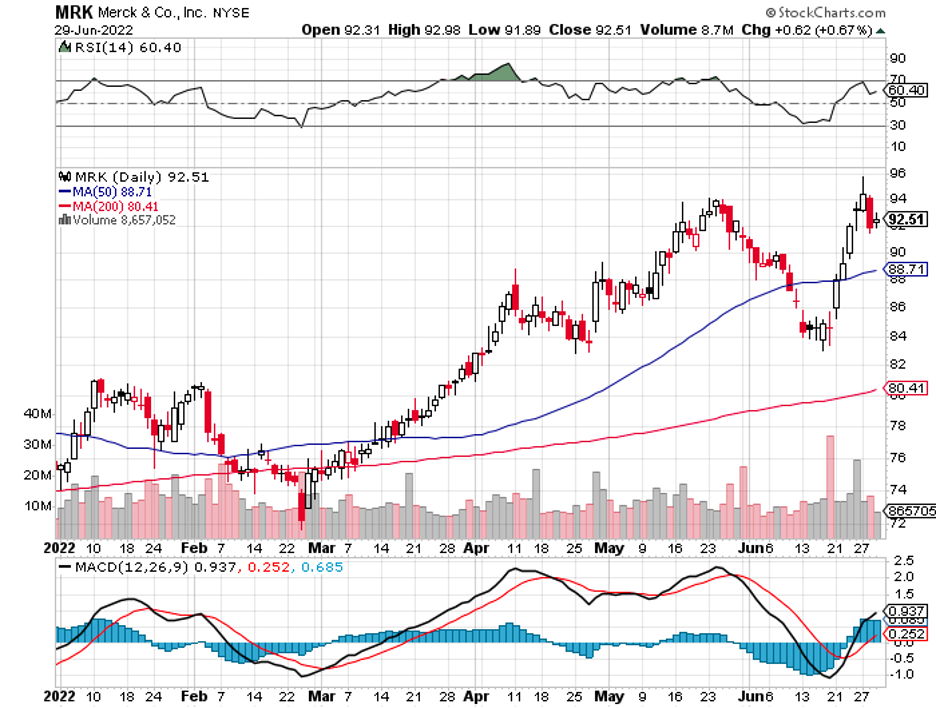
Mad Hedge Biotech and Healthcare Letter
June 28, 2022
Fiat Lux
Featured Trade:
(A RESILIENT BUY-AND-HOLD STOCK)
(AZN), (MRK)
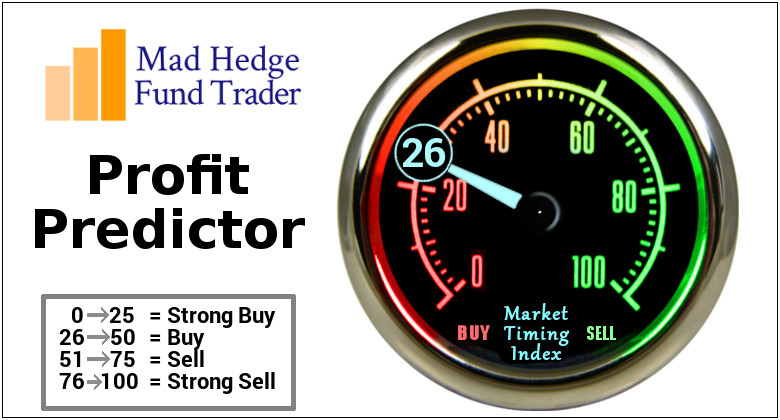
We officially entered a bear market when the S&P 500 continued to decline in value.
Falling by 23% since January, the index has battled constant pressure in 2022 as multiple issues like interest rate hikes and the war in Ukraine continue to make investors anxious over the future of the economy.
While the near-term prospects look gloomy for most businesses, there are several stocks that could be great buy-and-hold investments for the long term.
One of them is AstraZeneca (AZN), which has been in good shape to weather the turbulent conditions and still managed to generate solid results for its shareholders.
A critical factor in making AstraZeneca a top-performing growth stock is the broad range of drugs contributing to its top line.
The company has several blockbusters that generate over $1 billion in yearly revenue to fund its operations.
Needless to say, diversification is critical to appease investors to assure them that they’re not heavily relying on a single product.
Among the products under development for AstraZeneca, one of the most exciting prospects for this year is Enhertu.
Enhertu was just recommended in the European Union as a form of treatment for high-risk breast cancer patients.
This drug, developed with Japan’s Daiichi Sankyo, is anticipated to become another significant growth driver for AstraZeneca.
Breast cancer is the most widely reported type of cancer in the US. It takes over 40,000 lives annually.
Given the latest development and approval for Enhertu, this drug could potentially cover three times as many patients as the existing standard of care.
With the latest endorsement from the EU, Enhertu is estimated to reach $6.6 billion in peak sales. This is $2.5 billion more than the initial projection for this breast cancer treatment.
Aside from Enhertu, the European Union also endorsed Lynparza. This is another AstraZeneca treatment for breast cancer, which it developed jointly with Merck (MRK).
The expansion of its oncology business bodes well for AstraZeneca since it demonstrates a more diverse pipeline.
In 2021, the company acquired a highly sought-after rare disease biotechnology company, Alexion Pharmaceuticals, in an effort to expand its portfolio.
So far, this bet has paid off, with rare disease revenue from Alexion’s programs reaching a total of $1.7 billion in the first quarter of 2022.
To date, this particular segment comprises more than 15% of the total product revenue of AstraZeneca.
Another key strength of AstraZeneca is its strong pipeline and impressive innovation engine, with the company listing over 180 programs queued for development.
The latest developments in its promising programs involve potential breast and liver cancer treatments. In addition to its oncology lineup, the company is also developing new therapies for asthma.
Recently, the company disclosed the creation of a new R&D center in Massachusetts.
The plan is to establish a site for both AstraZeneca and Alexion’s workforces to integrate and work together. That could mean an expanded program for its rare disease portfolio.
In the first quarter of 2022, AstraZeneca’s renal, metabolism, and cardiovascular segments contributed $2.2 billion in sales, showing off a 14% increase from last year’s performance.
Meanwhile, oncology is still the top business of the company, making up 30% of its revenue of roughly $3.4 billion in the first quarter of the year.
Considering that Enhertu is still in its early phase, this number is expected to climb higher in the coming months.
Clearly, AstraZeneca has multiple growth opportunities within reach this year, making it an exciting stock to own.
Moreover, cancer care represents a continuous demand and will not be suspended for reasons like a recession or inflation.
As a leading oncology company, AstraZeneca is a relatively resilient investment despite the uncertainties.
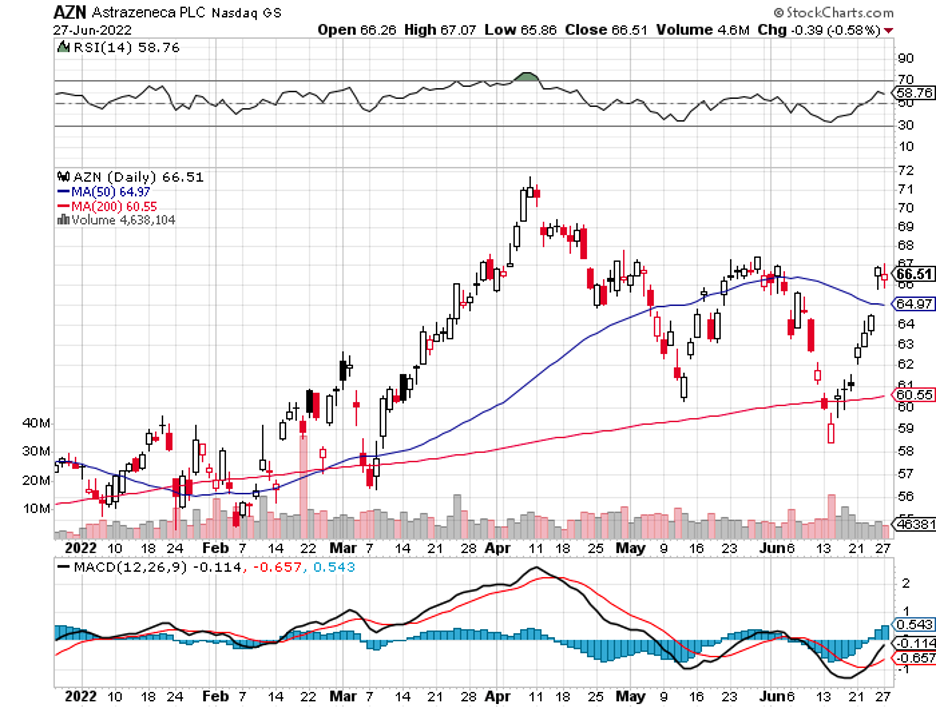
Legal Disclaimer
There is a very high degree of risk involved in trading. Past results are not indicative of future returns. MadHedgeFundTrader.com and all individuals affiliated with this site assume no responsibilities for your trading and investment results. The indicators, strategies, columns, articles and all other features are for educational purposes only and should not be construed as investment advice. Information for futures trading observations are obtained from sources believed to be reliable, but we do not warrant its completeness or accuracy, or warrant any results from the use of the information. Your use of the trading observations is entirely at your own risk and it is your sole responsibility to evaluate the accuracy, completeness and usefulness of the information. You must assess the risk of any trade with your broker and make your own independent decisions regarding any securities mentioned herein. Affiliates of MadHedgeFundTrader.com may have a position or effect transactions in the securities described herein (or options thereon) and/or otherwise employ trading strategies that may be consistent or inconsistent with the provided strategies.
This site uses cookies. By continuing to browse the site, you are agreeing to our use of cookies.
OKLearn moreWe may request cookies to be set on your device. We use cookies to let us know when you visit our websites, how you interact with us, to enrich your user experience, and to customize your relationship with our website.
Click on the different category headings to find out more. You can also change some of your preferences. Note that blocking some types of cookies may impact your experience on our websites and the services we are able to offer.
These cookies are strictly necessary to provide you with services available through our website and to use some of its features.
Because these cookies are strictly necessary to deliver the website, refuseing them will have impact how our site functions. You always can block or delete cookies by changing your browser settings and force blocking all cookies on this website. But this will always prompt you to accept/refuse cookies when revisiting our site.
We fully respect if you want to refuse cookies but to avoid asking you again and again kindly allow us to store a cookie for that. You are free to opt out any time or opt in for other cookies to get a better experience. If you refuse cookies we will remove all set cookies in our domain.
We provide you with a list of stored cookies on your computer in our domain so you can check what we stored. Due to security reasons we are not able to show or modify cookies from other domains. You can check these in your browser security settings.
These cookies collect information that is used either in aggregate form to help us understand how our website is being used or how effective our marketing campaigns are, or to help us customize our website and application for you in order to enhance your experience.
If you do not want that we track your visist to our site you can disable tracking in your browser here:
We also use different external services like Google Webfonts, Google Maps, and external Video providers. Since these providers may collect personal data like your IP address we allow you to block them here. Please be aware that this might heavily reduce the functionality and appearance of our site. Changes will take effect once you reload the page.
Google Webfont Settings:
Google Map Settings:
Vimeo and Youtube video embeds:
